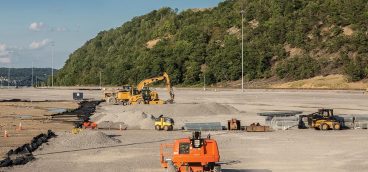
Oct. 8, 2009, at the Kearns Well near Brush Run, Washington County: As industrial accidents go, this wasn’t a particularly bad one. A valve on a massive water tank had failed.
Designed for the low hydrostatic pressures encountered in the flatlands out west, the valve had been no match for the pressures generated by the hilly terrain of western Pennsylvania.The workers at Range Resources moved quickly to stanch it, but before they could, some 250 barrels of “frac water”—about 11,000 gallons of partially recycled water that had already made the mile-long trip into the bowels of the buried Marcellus Shale to shatter the stone and free the gas trapped in it—poured out onto the ground.
Some of it oozed toward an unnamed tributary of Brush Run, killing 200 small fish, Range would later report.
It was a comparatively rare accident, one of only a handful that have occurred in the Marcellus since work began on hundreds of wells tapping into the massive—nearly 500 trillion cubic feet— ossified sea of natural gas inside it, according to the state Department of Environmental Protection. But it happened at a time when the industry was already getting a black eye. A few months earlier, and a couple of hundred miles away in Bradford County, the gas company Chesapeake, one of the giants of the Marcellus, and its subcontractor, the industry leader Slumberger, had accidentally dumped 259 gallons of hydrochloric acid on the ground at one of their drill sites. To remedy the problem and mollify the DEP, Chesapeake had to dispose of more than 11,000 tons of contaminated soil.And just a few days before Range’s accident, in the little town of Dimock, in northeastern Pennsylvania’s Susquehanna County, Cabot Oil & Gas had yet another in a string of mishaps that began Jan. 1, 2009, when methane, apparently from one or more of its wells, migrated into a local water well, triggering a minor explosion and contaminating water supplies for half a dozen residents in the area.
The company was still struggling with fallout from that incident when, on Sept. 16, a more serious accident occurred at a well they were drilling on the Heitsman property just outside the village of Dimock. Cabot had carved out its pad and drilled its well on a rugged chunk of fallow farmland. It had finished drilling the Heitsman 4H, a horizontal well that plunged a mile deep and a mile out, when it summoned its contractors to frac the well. Two of the best-known names in the business had signed on for the project. Halliburton was handling the frac job itself, working with contractors for Baker Tanks, another well-known name in the industry, to handle the water supply. The project was going as planned when a Halliburton worker threw open a valve to release water from one of the 21,000- gallon mixing tanks. A coupling on a hose failed, sending somewhere between 1,050 and 2,100 gallons of frac water surging onto the ground. The water had already been treated with the frac chemicals, which included Halliburton’s own secret formula gelling agent LGC-35 CBM, which the company describes as a potential carcinogen. The chemicals accounted for about .05 percent of the fluid, but that was more than enough for the DEP to take notice.
While about 800 gallons of that initial spill were contained on the drill pad—the driller had built berms around part of the unit— hundreds of gallons at least had reached a wooded wetland that fed nearby Stevens Creek. By the time the DEP arrived, the contractor had already built a hay and dirt dam to keep any more of the liquid from reaching the creek, and another had been built in the creek itself to prevent the tainted fluid from drifting downstream. The spill killed a number of small minnows and frogs, but larger fish were spared.
Six hours later, at the same site, it happened again. It was a combination of mechanical and human error. According to Baker’s reports to the DEP, “a 12-inch diameter mechanical coupling… fitted upstream of the feed tank manifold failed…” and before the contractor could shut the system down, another 5,880 gallons of frac fluid poured onto the drill pad. With the berms and the makeshift dam still in place, only about 580 additional gallons made it to the wetlands and the creek beyond.
A week later, on Sept. 22, DEP was still mulling its options on how to handle the infractions at the Heitsman well when a third spill occurred. Once again, a hose failed. In most respects, this spill was deemed less dangerous than the previous spills. The water was being prepared for the seventh and final stage of the frac job and contained even less of the gelling agents. But even though only about 10 percent of the 480 gallons that had leaked on to the pad actually reached the berm, it was the last straw.
DEP shut down Cabot’s operation in Dimock and gave it 21 days to come up with more than a mea culpa; to devise a plan to prevent a recurrence. That plan is due in March.
Taken together, the three incidents caused relatively minor environmental damage, though they were significant enough that the DEP fined the operators. If the events had happened a decade earlier, in Texas or Oklahoma or some other remote part of the country where no one but the cattle and the catfish would have known about it, the spills wouldn’t have been considered a big deal at all. Work crews would have dropped absorbent battens on the ground—as they did in these cases—fixed the leak, and gotten right back to work. But this wasn’t the sage brush and arroyo of the remote west, this was the relatively tightly packed and densely populated state of Pennsylvania, where drillers are seldom out of sight of curious locals who often have mixed feelings about the whole idea of drilling in the Marcellus. And it was also 2009, the age of instant Internet communications, when news of any misstep or accident is quickly transmitted from one interested group to the next, amplifying whatever fears there are about the potential environmental dangers of the race to develop the Marcellus Shale.
It’s a measure of just how immediate and effective that communication is that, within hours of DEP’s temporary shutdown of Cabot’s fracking operation in Dimock, stock prices for the company and all of the principal Marcellus drillers took a brief but bracing nose dive. And while prices quickly recovered, it was, several drillers have acknowledged, a stark reminder that, in the Marcellus at least, when one company sneezes, the industry catches a cold.
As Kristi Gitten, vice president of public affairs at Chief Oil and Gas, a major player in the Marcellus, put it, “There’s not another industry on the planet that could spill a drop of water and have it be front-page news. We operate under such a microscope that I challenge any industry out there to operate under that same microscope.”
And in the wake of those incidents, the normally independent drillers—among them the major operators in Pennsylvania such as Chief, Range, Atlas Energy Resources and XTO—have begun speaking with one voice, stressing their work to develop individually and collectively a series of “best practices.” Their stated aim is to go beyond the regulations imposed by state and federal agencies and not only reduce the environmental impact of drilling operations in Pennsylvania, but also try to persuade the public at large that the cleaner, domestically produced carbon fuel they’re ferreting out can be extracted safely.
“I think everyone needs to get on board with the fact that we’re benefiting from producing this natural resource, and we need to use methods that promote good environmental consciousness,” says Kevin West, the spokesman for EQT, which operates several wells in Washington and Greene counties.
It’s a sentiment echoed by virtually all of the drillers. “We know how to do this in balance with the environment, and… we want to do the right thing,” says Ray Walker, the Range vice president charged with overseeing its Appalachian operations. “Most of us are avid outdoorsmen… very seldom do you find an engineer or a drill engineer or a drilling superintendent out on the rig that doesn’t enjoy fishing and hunting, and they all worry about that kind of thing.”
But translating that native concern into action, and persuading a sometimes skeptical public that the industry is sensitive to environmental concerns has sometimes proven to be a challenge in itself.
There has been a fairly steep learning curve for drillers in the Marcellus, Walker says. As the failed valves and lines at the Kearns well in Washington County and the Heitsman well in Susquehanna demonstrated, the industry needs to share information about hazards peculiar to the Marcellus, and informally they are doing just that. In after-hours chats among drilling engineers and safety experts, for example, several drillers examined the failures that led to the methane migration into water wells in Dimock and came up with ways to guard against a recurrence. But Walker acknowledges that the industry needs to go further. There is, he says, “a big effort going on within the industry to try to create, I guess, industry standards or best practice standards” through the Marcellus Shale Coalition, a kind of trade group that encompasses most of the key players in the region.
Perhaps the most crucial issue that the developing standards will need to address is the use and disposal of water—the lifeblood of the hard shale drilling operations in the Marcellus, says Tim Weston, an attorney specializing in gas and oil law for K&L Gates, which represents some of the largest drillers in the region. To wrest the tightly trapped gas from the deeply buried rock, drillers must force millions of gallons of water— up to three million gallons in some cases—deep into the earth under such pressure that it fractures (“fracs”) the shale and allows the gas to flow. In order to withstand the long trip and the harsh conditions underground, that water must be treated with a host of chemicals and compounds, friction reducers and biocides, elements that keep the water from damaging the driller’s equipment and pipes. Some of those chemicals are toxic. When the water returns to the surface, as anywhere between a third to 60 percent of it does, it must be treated and disposed of, reducing not only the chemicals that the drillers added, but also the longburied salts and other solids that the water picked up during its subterranean sojourn.
The challenges have prodded the industry to begin to develop a strategy to “recycle” the so-called flowback water, thus reducing both the amount of water that’s drawn from the state’s three main watersheds—the Ohio River basin, the Susquehanna River basin and Delaware River basin—and to reduce the amount of it that’s pumped back into the rivers and streams at the end of the process.
Actually, the term “recycling” may be a misnomer. While a significant amount of the water recovered from the gas wells can be reused, says Erika Staaf, a clean water advocate for Penn Environment, one of the state’s leading environmental organizations and one that has been pressing for more stringent environmental oversight of the industry, that flowback water must still be diluted. And that, she says, can require millions of gallons of fresh water drawn from the state’s supplies. In fact, Range, which now boasts that it reuses 100 percent of its flowback water, must draw 3 million gallons of fresh water for every million gallons of flowback water that it reuses. Atlas and other drillers who are also actively reusing flowback water use a similar ratio. But even recycling—or reuse, if you prefer—is not without challenges, especially on the regulatory level, says Joseph Reinhart, an attorney with Babst, Calland, Clements and Zomnir, a Pittsburgh firm that represented several key players in the Marcellus. “Recycling of these materials is something that everybody agrees makes sense,” Reinhart says. “But of course we’re not trying to figure out how the laws that apply to wastewater fit into that.” The danger is that regulations governing wastewater that is to be treated and discharged through treatment facilities, if applied to wastewater that is to be reused, could have a chilling effect on the developing practice of reuse. “There’s a challenge for everyone to say, ‘we want to recycle… how do we allow it to happen without interfering with the ability to use good practices as opposed to blindly applying what would apply if you had a wastewater that you were managing?’ ” Reinhardt says.
One step might be to reduce the overall amount of water being fed into and out of the system and steps are now being taken to reduce the amount of water drawn from the state’s watersheds. “Increasingly, the Marcellus Shale operators are sharing water supplies,” says Weston of K&L Gates. “I think that it is a laudable practice, it results in fewer intakes and allows for use of resources in a more efficient fashion.”
What’s more, drillers are also looking at other sources for their water supplies, most intriguingly at what one researcher has called Pennsylvania’s “unnatural resource”: acid mine water. Beginning this spring, Kelvin Gregory, a professor of engineering at Carnegie Mellon University, will begin assembling a team of researchers both from his school and the University of Pittsburgh that will spend the next three years studying the potential use of acid mine water as a component of frac water. Underwritten by a $1 million grant from the federal Department of Energy, the idea is to use the acidic water to treat flowback fluids with an eye toward not only reducing the amount of fresh water needed to dilute it for reuse, but at the same time, to draw down the state’s copious supplies of the noxious byproduct of the state’s last great energy boom.
Gregory’s researchers are not the only ones evaluating acid mine water. Already, Atlas is conducting experiments with acid mine water drawn from one southwestern Pennsylvania site, and the results have been promising, says Rich Weber, that company’s president and chief operating officer. Other drillers are considering following suit.
As promising as those developing practices may be, there is one more abundant and potentially toxic byproduct of the race to develop the riches of the Marcellus that both drillers and environmentalists need to consider: the vast and growing mistrust between the two camps.
As the development of the Marcellus has heated up, marked by periodic missteps, so too has the acrimony on both sides, says Gregory, who has watched the unfolding debate with the kind of bemused detachment typical of academics. “You’ve got corporate interests on the one side that are really over-minimizing the potential impact of natural gas development from the Marcellus,” Gregory says. “You’ve got some environmentalists that are speaking entirely in hyperbole… using examples of incidents that occurred in Colorado… in coal bed methane, which is a very different process… using sleight of hand and smoke and mirrors to generate emotional response. There’s so much hyperbole being generated on either side of the equation that it’s really hard to sift through what is the reality. Finding the truth has become very difficult.”
But recently, there has been a growing awareness from both the drillers and the environmentalists that perhaps the time has come to bridge that gap. Staaf of Penn Environment says the development of the Marcellus, while still in its infancy, is progressing with a certain level of inevitability. happening,” she says. “We understand that it’s moving forward; there’s not much that anyone can do to stop it. However, if it’s going to be done it has to be done in mind of public health, drinking water and the environment.”
To that end, some of the environmental organizations have begun to take a role as shareholders in some of the companies operating in the Marcellus. The Green Century Fund, an investment firm that uses its cash resources to invest in companies that it can then work with and prod toward more environmentally sensitive policies, has been directing its resources increasingly toward companies operating in the Marcellus and has been using its standing as a shareholder to influence policy, according to Lorissa Ruoff, the fund’s director of shareholder advocacy. She declined to identify the companies in which the fund has invested.
And the industry has come to understand that, even if it can never hope to get the unqualified support of the environmental community, it at least needs to make sure that those interests have a voice in the process, says Walker, who in addition to his duties at Range also chairs the Marcellus Shale Coalition. To that end, he said, the industry in general and the coalition in particular have begun reaching out to conservation groups and the press, in hopes of finding some common ground and maybe even some new ideas on how to develop what lies beneath that ground.
“We’re doing a lot of that right now,” Walker says. “We’re going to form some committees to work on those sorts of things, not only the conservation groups, but we’re willing to bring media into the fold now… we’re certainly opening up lines of communication with all of those groups… There’s expertise that conservation groups have that we would like to make sure we understand…We’re trying to use all the best practices that we know how to use and if somebody at the Nature Conservancy or any of the other groups can come up with a better way for us to do something, we need to know that.” That’s not to say that there will never be another repeat of the type of incidents that occurred at the Kearns well, or in “We are not looking to stop this from Bradford or Susquehanna counties, Walker concedes. “We know that there will be mishaps. Any kind of industry doing anything at all is gonna have mishaps. What our goal is, is to remediate those as quickly as possible when they do happen, and our goal is to try to prevent them and get the frequency down to actually nothing if we can. Our goal is zero.”
And the best way to achieve that goal, he says, is to use the state’s other resources—from the pernicious ones such as acid mine water, to the positive ones, such as the expertise of both the drillers and the environmental community, to the fullest.





